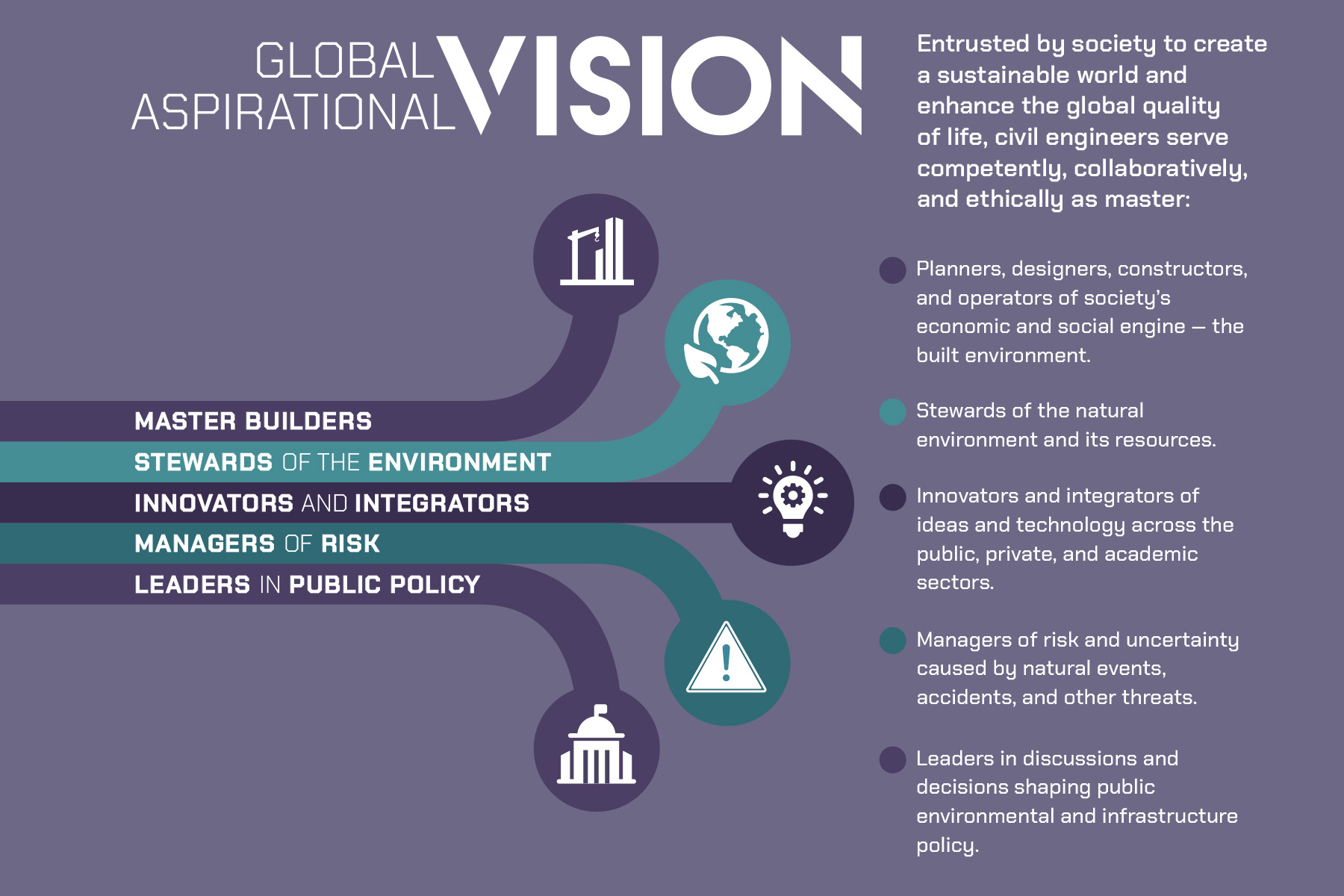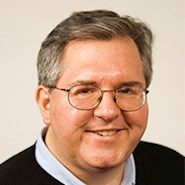
By Robert L. Reid
Nearly two decades ago, ASCE launched a project to formulate a global vision on the future of civil engineering. Progress has been made, but much of that effort remains unfinished even as the profession confronts new challenges and opportunities.
In June 2006, ASCE hosted the Summit on the Future of Civil Engineering in 2025 at a conference center in northern Virginia. Gathering more than 60 leading civil engineers and other experts from around the world, the three-day event focused on articulating a global vision for civil engineering, according to the report, The Vision for Civil Engineering in 2025, that the summit produced. That summit was followed by the work of an ASCE task committee that produced another report in 2009, Achieving the Vision for Civil Engineering in 2025: A Roadmap for the Profession.
This document established “an ambitious ‘roadmap’ for civil engineers to shape their own future and grasp a bold Vision for their profession,” according to the report. Dubbed Vision 2025, the roadmap featured five key outcomes — and more than 100 tactics aimed at supporting those outcomes — that the summit and task committee participants hoped would be hallmarks of civil engineering two decades hence.
These five outcomes are that civil engineers would be:
- Master builders
- Stewards of the environment
- Innovators and integrators
- Managers of risk
- Leaders in public policy
Having now reached the target year of 2025, Civil Engineering spoke with leaders in the profession — some who worked on Vision 2025 and others who have followed its progress — to discuss what parts of that roadmap have been achieved, what work remains to be done, and what the future holds for the profession beyond 2025.
Achieving aspirations?
For Kenneth Rosenfield, P.E., ENV SP, F.ASCE, a senior project manager at the Ardurra Group Inc., in Newport Beach, California, the results of Vision 2025 are somewhat mixed. In October 2023, while serving on the ASCE Board of Direction, Rosenfield chaired a task committee that examined the status of Vision 2025 efforts. The conclusion of the report this task committee produced was that none of the 106 tactics from Vision 2025 has yet been fully achieved, while more than 70 are in the process of being achieved. But ASCE has “embraced the language of Vision 2025 and incorporated many of the precepts” into the Society’s strategic plan, he says.
Noting that the goals of Vision 2025 are “aspirational and continuous,” the task committee report concluded that no time limits should be placed on efforts to achieve those original targets — while also recognizing that new and additional civil engineering challenges have developed over the past 16 years since the Vision 2025 initiative began. Moreover, Rosenfield added, Vision 2025 “is seminal work that is applicable to today’s civil engineering profession with aspirational goals to be regularly reviewed, utilized, and updated.”

Blaine Leonard, P.E., BC.GE, Pres.10.ASCE, the transportation technology engineer at the Utah Department of Transportation, participated in the 2006 summit and chaired the ASCE task committee that produced the Achieving the Vision report. From his perspective, civil engineers have made progress in areas such as environmental stewardship, especially in terms of sustainability, as well as being master innovators and integrators. But he sees little improvement in areas such as becoming leaders in public policy or managers of risk and uncertainty. And the future scenarios projected in Vision 2025 have not necessarily developed as predicted.
For example, Vision 2025 expected nanotechnology to become an important part of civil engineering by 2025, which has not happened, Leonard notes. Instead, the advancement of computational power and artificial intelligence — which were not anticipated in Vision 2025 — are actually “having a significant impact on how we practice,” Leonard says.
Michael D. Mucha, P.E., ENV SP, F.ASCE, another summit participant, points to “some strides” that the civil engineering profession has made over the past decade and a half that relate to Vision 2025 goals. ASCE’s work to develop the Envision rating system and the Institute for Sustainable Infrastructure have changed “how we look at infrastructure,” demonstrating the profession’s role as environmental stewards, notes Mucha, who is retired but continues to consult for nongovernmental organizations on water issues.
Richard M. Kunnath, P.E., M.ASCE, the board president of the Charles Pankow Foundation, served as a member of the Summit on the Future of Civil Engineering in 2025 and a corresponding member of the Achieving the Vision Task Committee. He feels that while the effort correctly identified problems such as the need for greater political influence by civil engineers, there has been “no concentrated effort or strategic planning” on how to achieve such goals.
As far as civil engineers being recognized as master integrators, Kunnath sees mixed results. On traditional civil engineering projects, he feels the profession has made progress. But there has been less progress on projects that heavily rely on advanced software or other new technologies, such as smart buildings or smart roadways — projects that might involve “one part civil engineering (and) two or three parts electrical engineering or computer science,” he explains.
Thinking ahead
Various forward-looking efforts in the civil engineering profession that were not directly part of Vision 2025 have nonetheless built on the groundwork of that earlier program, notes David J. Odeh, P.E., S.E., F.SEI, F.ASCE, senior vice president and national director of building structures at WSP USA Buildings Inc. Odeh says he was inspired by Vision 2025 when he served on the board and as president of ASCE’s Structural Engineering Institute. Likewise, he says ASCE’s Future World Vision initiative, which he helped develop, “builds on the Vision 2025 effort.”
Although both Vision 2025 and Future World Vision rely on what Odeh calls “scenario planning,” he sees a crucial difference. Vision 2025 represented trying to determine “what we wanted the world to be like for civil engineers” in the future, Odeh says. By contrast, Future World Vision involves “a variety of scenarios that might occur 50 or more years in the future, whether we liked them or not.” These included “disruptive events that could dramatically change our world, the profession, or infrastructure in general,” he explains.

Looking ahead, what will the world be like for the civil engineer of 2050, 2075, and beyond?
In terms of disruptive developments, one of the most likely to shake things up for civil engineers is AI. It is a development definitely on the mind of Eva Lerner-Lam, NAE, Dist.M.ASCE, the president of Palisades Consulting Group Inc. and a participant on the Achieving the Vision Task Committee. Lerner-Lam chairs ASCE’s AI Readiness Task Committee, which is examining how this technology intersects with the civil engineering industry and is considering “ways to protect intellectual property while using ASCE’s knowledge base to advance civil engineering practice,” the ASCE website explains.
That knowledge base — which Lerner-Lam describes as “3V,” for validated, verified, and valuable — monetizes information primarily through documents, books, PDFs, and similar hard copies of printed material. Metaphorically, people “knock on our door and pay us” for that information in a physical form, she says. But the future of such information exchanges is digital. Going forward, people will primarily access information through application profile interfaces, digital intelligence tokens, agentic AI systems, and other digital methods. So, if ASCE does not adapt to AI, its “knowledge base is unlikely to be accessed by agentic AI services. Nobody’s going to knock on our door and pay for the information.”
Lerner-Lam and others interviewed for this article are also concerned about the recent reductions in federal funding for scientific research and its impact on major universities. Whether these trends will be short-lived or long-lasting is unknown, but she points out that civil engineers are renowned for being able to “adapt and respond to very rapidly changing circumstances. We deal with emergencies and crises all the time — it’s why we went into engineering!”
Addressing change
Looking beyond 2025, the effects of climate change mean that the civil engineering profession will “need to address a future that is unknown,” says Mucha. In the past, he explains, civil engineers could make plans based on the assumption that future weather and climate systems would be relatively similar to what had been experienced previously. Many civil engineering standards were based on that assumption, for example. But going forward, civil engineers will face a world of non-stationarity in which “we cannot predict future operating conditions,” Mucha says.
In his career, which included serving as the executive director of a regional wastewater utility in Madison, Wisconsin, it was common to install new pipes that were expected to last a century or more, Mucha says. But now it’s clear that “it’s going to be a very different world in 100 years.” So in the future, civil engineers will likely design systems “on a more short-term basis, a more flexible timeframe to adapt to changing conditions.”
Rather than designing a single, enormous infrastructure project, this approach might involve smaller, satellite facilities that can be constructed as demand requires and expanded, or not, depending on demand. This way, the engineers “can add capacity easily or throttle things back without huge sunk costs in bricks and mortar.”
For Odeh, the challenges of climate change demonstrate the need for civil engineers to better understand principles of uncertainty and probability and how such ideas are “embedded in all the decisions we have to make as engineers.” When engineers design a structure to accommodate a maximum snow load of, say, 30 lb/sq ft, “we know that that number is based on probability and uncertainty theory,” Odeh points out. “You do not know what the exact annual snowfall will be on a roof, so we try to build in some factor of safety based on a reasonable understanding of the risk and uncertainty inherent in that load.”
But it’s “also important to understand that our knowledge of that uncertainty, some of our basic foundations that we used to establish those loads, are changing because of climate change or other changes in the environment that impact the loads and the uncertainty in a fundamental way,” he explains.
Although Vision 2025 encouraged engineers to learn a body of knowledge that includes uncertainty and probability theory, “what I’m talking about is taking it to the next step, of really understanding and applying uncertainty, risk, and reliability to our practice — using probabilistic methods, adaptive-design methods, and performance-based engineering to make you a better decisionmaker,” Odeh says.
Confronting risks
Another issue of concern involves the shifting of financial risk onto engineering firms, says Ron Klemencic, P.E., S.E., NAC, NAE, F.SEI, Dist.M.ASCE, chair and CEO of Magnusson Klemencic Associates. “When I started my career, it was common for an engineering firm to carry $1 million in professional indemnity insurance,” says Klemencic. But now, four decades later, “there’s a growing pressure to carry $10 million in insurance.” But while such insurance requirements have increased tenfold over that period, compensation for engineering work has only roughly doubled, Klemencic notes.
This “growing divide between how much we’re being compensated to take the risk and how much risk we’re being asked to take ... could break the profession,” Klemencic warns. It is a problem especially for medium-sized and smaller firms that cannot tolerate that level of risk, he adds.
Although Klemencic concedes there is “no good answer right now” to this issue, and exact numbers that demonstrate the problem are difficult to obtain, he stresses that it is “something serious” the profession needs to address going forward.
Klemencic also worries that civil engineers are too focused on being what he calls “compliance officers,” which means they work primarily to demonstrate that their designs comply with a set of prescriptive rules in state and local building codes. Over the years, Klemencic adds, the scope of such codes has expanded from tens of pages of provisions to hundreds of pages. “The risk of being compliance officers,” he says, is that it leads to a lack of innovation, a lack of “doing engineering in its purest form, using our skills with math and science to invent new things!”
On this issue, Klemencic does see a good solution, which builds on ideas promoted in Vision 2025: performance-based design. But while the Vision 2025 effort discussed performance-based design, and there has been some progress on expanding its use over the years, Klemencic argues that “we need to up the volume!” As he explains, greater use of “performance-based design would open up a world in which you (as civil engineers) aren’t just trying to comply with a prescriptive set of rules, you can demonstrate that you can achieve objectives, and how you achieve those objectives by using your math and science and engineering skills is the beauty of it.”
With performance-based design, Klemencic says, there’s not just one answer — there’s a plethora of answers in which innovation and creativity can thrive.
Although many goals from Vision 2025 remain to be achieved, the exercise itself was worthwhile, according to Leonard. “We need to be aspirational because it puts us in a different mindset,” he explains. “It allows us to step back and survey the large picture ... and then when we settle back into the near term, we have those ideas and thoughts in our heads.”
That sort of introspection is what makes progress possible, Leonard says. “And we did make progress with Vision 2025, so the effort paid off in that regard.”
Robert L. Reid is the senior editor and features manager of Civil Engineering.
This article first appeared in the September/October 2025 issue of Civil Engineering as “Vision 2025 and Beyond.”



